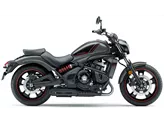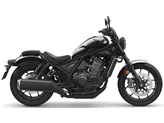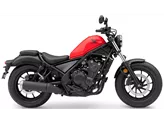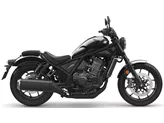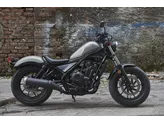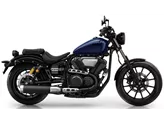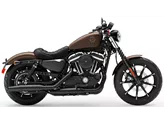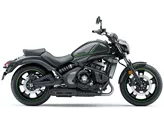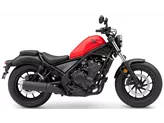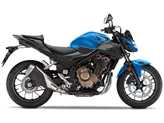Kawasaki Vulcan S 2015 vs. Honda CMX500 Rebel 2017

Kawasaki Vulcan S 2015

Honda CMX500 Rebel 2017
Overview - Kawasaki Vulcan S 2015 vs Honda CMX500 Rebel 2017
The Kawasaki Vulcan S 2015 and the Honda CMX500 Rebel 2017 are both chopper/cruiser motorcycles that offer unique features and specifications.
Starting with the engine and drive train, the Kawasaki Vulcan S 2015 is equipped with an in-line engine that has a bore of 83 mm and a stroke of 60 mm. It delivers a powerful engine power of 61 HP and a torque of 63 Nm. The transmission is a chain drive, and it has 2 cylinders with liquid cooling. The displacement of the engine is 649 ccm. On the other hand, the Honda CMX500 Rebel 2017 also has an in-line engine but with a smaller bore of 67 mm and a stroke of 66.8 mm. It has a slightly lower engine power of 46 HP and a torque of 44.6 Nm. The transmission is also a chain drive, and it has 2 cylinders with liquid cooling. The displacement of the engine is 471 ccm.

Kawasaki Vulcan S 2015
Moving on to the chassis, both motorcycles have a steel frame that provides stability and durability. The front brakes of both motorcycles are single disk type.
In terms of dimensions and weights, the Kawasaki Vulcan S 2015 has a front tire width of 120 mm and a diameter of 18 inches. The rear tire width is 160 mm with a diameter of 17 inches. It has a wheelbase of 1575 mm and a seat height of 705 mm. The kerb weight (with ABS) is 228 kg, and the fuel tank capacity is 14 liters. On the other hand, the Honda CMX500 Rebel 2017 has a front tire width of 130 mm and a diameter of 16 inches. The rear tire width is 160 mm with a diameter of 16 inches. It has a slightly shorter wheelbase of 1488 mm and a lower seat height of 690 mm. The kerb weight (with ABS) is 190 kg, and the fuel tank capacity is 11.2 liters.
Now let's discuss the strengths and weaknesses of each motorcycle. The Kawasaki Vulcan S 2015 has a rev-happy engine that performs well in both high and low rev ranges. It also has a decent brake system with ABS for added safety. The motorcycle has an idiosyncratic look that sets it apart from other cruisers. The narrow 160 rear tire contributes to its maneuverability. Additionally, the Ergo-Fit system allows for optimum adaptation to the rider's preferences. The chassis provides sufficient comfort for long rides. However, the Ergo-Fit system comes at an extra cost, and the wind protection is moderate. Furthermore, the gear indicator is only available as an option.

Honda CMX500 Rebel 2017
On the other hand, the Honda CMX500 Rebel 2017 has a lively engine that offers a thrilling riding experience. The chassis is well set-up, providing a smooth and comfortable ride. The motorcycle has a great look that appeals to riders looking for a stylish cruiser. The low seat height makes it accessible to riders of all sizes. Additionally, the motorcycle has a nimble handling, allowing for easy maneuvering in tight spaces. However, the lean angle clearance is limited, which may affect the motorcycle's performance in sharp turns. The small fuel tank capacity may require more frequent refueling on long rides.
In conclusion, both the Kawasaki Vulcan S 2015 and the Honda CMX500 Rebel 2017 offer unique features and specifications. The Kawasaki Vulcan S 2015 has a more powerful engine and a larger fuel tank capacity, while the Honda CMX500 Rebel 2017 has a lower seat height and a lighter weight. Ultimately, the choice between the two motorcycles depends on the rider's preferences and priorities.
Technical Specifications Kawasaki Vulcan S 2015 compared to Honda CMX500 Rebel 2017
Pros and Cons in comparison
Pros and Cons in comparison
Kawasaki Vulcan S 2015

La Vulcan S redonne vie à la scène des "petits" cruisers de classe moyenne - et ce non seulement en raison de son design original, mais aussi de sa facilité de conduite qui vise particulièrement les débutants. La hauteur de selle basse et la selle étroite favorisent une bonne stabilité du pilote au sol, tandis que le centre de gravité bas assure une maniabilité simple et sûre. Le moteur s'adapte lui aussi parfaitement à l'allure simple de la moto, il peut monter en régime à partir de 2000 tours et ne s'arrête qu'à environ 10 000 tours - du jamais vu sur un cruiser. Le système "Ergo-Fit", qui fait varier la hauteur de selle, la distance du pilote par rapport au guidon et aux repose-pieds, coûte certes un supplément, mais permet au propriétaire de la Vulcan S de bénéficier de généreuses possibilités de personnalisation.
Honda CMX500 Rebel 2017

Nous aspirons tous à la diversité et la Honda Rebel apporte justement cette diversité à la catégorie de permis A2. Il s'agit d'un merveilleux élargissement de la gamme de modèles Honda et ne convainc pas seulement les débutants. Le réglage du moteur et du châssis en font un cruiser très détendu, avec lequel glisser devient un plaisir. L'optique est purement pragmatique, elle brille pratiquement par son minimalisme. Un ensemble cohérent pour une détente à moto économique.
Price Comparison Avarage Market Price Kawasaki Vulcan S vs Honda CMX500 Rebel
There are a few key differences between a Kawasaki Vulcan S 2015 and a Honda CMX500 Rebel 2017. In terms of price, the actual average price of a Kawasaki Vulcan S 2015 is about 26% higher. A Kawasaki Vulcan S 2015 experiences a loss of 380 USD in one year and 400 USD in two years of ownership. This is offset by a loss of 10 USD and 280 USD for a Honda CMX500 Rebel 2017. There are the same number of bikes of both models available on the 1000PS.de marketplace, specifically 8. It takes less time to sell a Kawasaki Vulcan S with 75 days compared to 84 days for a Honda CMX500 Rebel. Since model year 2015 1000PS.de editors have written 13 reviews for the Kawasaki Vulcan S and 16 reviews for the Honda CMX500 Rebel since model year 2017. The first review for the Kawasaki Vulcan S was published on 10/16/2014 and now has more than 14,800 views. This compares to more than 150,600 views for the first review on Honda CMX500 Rebel published on 4/3/2017.


